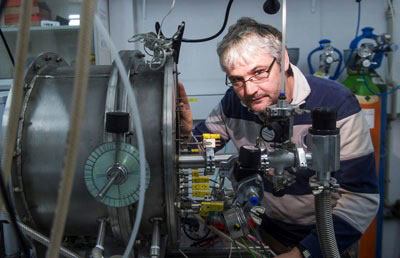| Jul 24, 2014 |
Improving the features of solar thermal collectors by measuring infrared emissivity
|
|
(Nanowerk News) Researchers in the UPV/EHU’s department of Condensed Matter Physics have developed the only infrared emissivity radiometer existing in Spain. The university is also one of the few centres worldwide that have this kind of device. Many research centres and companies have taken advantage of this possibility and collaboration has been set up with this research group to obtain absolute, reliable measurements of the emissivity of their materials, tools or components. In the most recent collaboration they have participated in, they have been working to improve the efficiency of solar collectors ("Spectral emissivity of copper and nickel in the mid-infrared range between 250 and 900 °C").
|
 |
| Researcher Raúl Pérez beside the infrared radiometer developed.
|
|
At any temperature above absolute zero all bodies or objects emit heat in the form of electromagnetic radiation. At temperatures of between room temperature and over 1,000 ºC, the emission mostly takes place in the medium infrared range, in other words, at wavelengths of between 1.5 and 25 micra. The physical property that allows this radiation to be characterised is infrared emissivity. There are no commercial devices available on the market for measuring this magnitude, and worldwide few centres have a radiometer. The UPV/EHU is one of them thanks to a research group that has designed, built and calibrated one.
|
|
In certain sectors and for certain applications, it is very important to know the emissivity of the materials and components used. “From the more scientific point of view, these measurements enable us to determine optical or dielectric constants, and from the practical point of view, they are important for measuring temperature by means of pyrometry and when building any system in which the temperature is an important factor, as in building or oven insulation, etc.,” pointed out Raúl Pérez, lecturer in the research group responsible for developing the device.
|
|
Depending on the type of application concerned, “a material may need to have low or high emissivity, although what is known as selective emissivity is often needed; this means that the material has to have high emissivity for a certain range of wavelengths and low emissivity for others," explained the researcher.
|
|
In connection with that latter feature is the most recent collaboration in which they have been involved. They have been working on solar thermal energy collectors. “In this case, what one is trying to achieve is to get the materials that coat the collector tubes, through which the liquid that is heated by the energy captured by them passes, to absorb a lot in the wavelength ranges in which the solar radiation is received (it tends to be of the visible range), and little in the infrared range, which is the range in which bodies emit radiation,” explained the researcher.
|
|
A comparative method
|
|
The method for measuring infrared emissivity developed by the UPV/EHU’s department of Condensed Matter Physics is a direct method for measuring the emissivity of opaque bodies, and consists of comparing what is emitted by the body in question with what is emitted by a black body. A black body is regarded as the ideal emitter. As an ideal emitter, the radiation emitted by a black body is determined exactly by Planck’s law of radiation. Yet in other materials the radiation emitted is determined by “multiple parameters which make modelling it quite complicated. In general, it displays dependency on the temperature, wavelength and emission angle, apart from the state of the surface, like roughness, porosity, oxidation state, etc.,” pointed out Pérez.
|
|
Since 2006 when they designed the radiometer in response to a request made by the company ITP, who were keen to know the emissivity of parts of the turbines of turboprops manufactured for aircraft, they have received many “requests from companies to conduct these measurements, and on occasions we have not been able to meet all the demand we receive,” remarked the researcher. What is more, as time passes they have been expanding the capabilities of the radiometer like the spectral range that can be measured, or the temperature range in which the machine can operate.
|
|
Additional information
|
|
The research team comprises two lecturers, Manuel Tello and Raúl Pérez, and two trainee researchers Telmo Echaniz and Iñigo Setién. The research and developments carried out in connection with the infrared emissivity radiometer have led to two PhD theses in addition to a whole host of publications in international scientific journals. Among the organisations they have been collaborating with is the company ITP, MU-Mondragon University, the EUROATOM-CIEMAT Association, the Institute of Materials Sciences of Madrid (ICMM) and Tecnalia.
|

